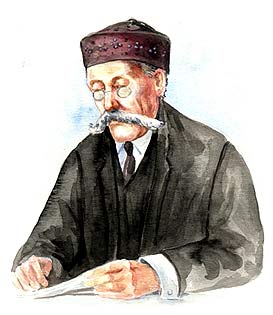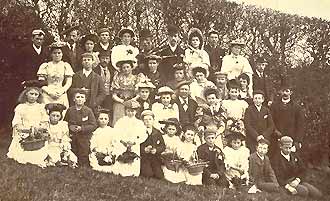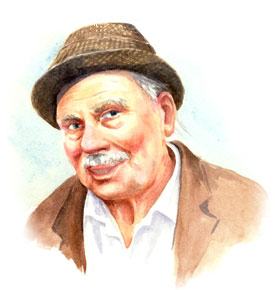Principal Collectors of Song, Music & Dance
Gavin Greig (1856 - 1914)
"One of the most successful and pertinacious researchers that have explored the realm of ballad literature." JMH
 Gavin Greig, scholar, intellectual and tireless champion of Buchan's culture
and tradition, was born at Parkhill, Newmacher, Aberdeenshire, on 10th
February 1856. He was educated at Aberdeen University and later became
a teacher at Whitehill School, by New Deer, where he remained until his
death on 31st August, 1914.
Gavin Greig, scholar, intellectual and tireless champion of Buchan's culture
and tradition, was born at Parkhill, Newmacher, Aberdeenshire, on 10th
February 1856. He was educated at Aberdeen University and later became
a teacher at Whitehill School, by New Deer, where he remained until his
death on 31st August, 1914.
In Greig's "Ballad Corner," a weekly feature in the local newspaper,
the Buchan Observer, he wrote about the songs and singers of the North
East, a subject close to the heart of the young J.M.H. and perhaps the
inspiration behind his devotion to the collecting of music and song. Though
Greig was a gifted poet and playwright, many of which were published in
the "Whistle Binkie" collections, his fame rests on the folk
song collection he made with the Rev J. B. Duncan, 1848-1917. Regarded
by many as the greatest of its kind, the immense Greig - Duncan collection
was eventually published in an eight volume set.
 The original cast of the New Deer production of Greig's play Mains Wooin',
a humorous tale of the trials and tribulations of life in rural Buchan
first performed in New Deer in 1894. (Ritchie Collection)
The original cast of the New Deer production of Greig's play Mains Wooin',
a humorous tale of the trials and tribulations of life in rural Buchan
first performed in New Deer in 1894. (Ritchie Collection)
Greig is seated near centre, wearing a bonnet.
Francis J. Child (1825-1896)
Francis James Child's five volume work, The English and Scottish Popular Ballads (1882-1898), is considered by many as the "canon" of folk music.
 He was born on February 1st, 1825, in Boston, Suffolk, United
States, the son of Joseph and Mary (nee James) Child. His father, a sailmaker,
could barely provide for his family let alone afford the education the
young Francis clearly deserved. After a time at Boston Grammar School and
later the English High School, and through the generosity of Epes Sargent
Dixwell (the principal of the Boston Latin School who recognised Child's
genius) Child was able to enter Harvard. He graduated first in his class
and was offered a position in mathematics and later in history and political
economics.
He was born on February 1st, 1825, in Boston, Suffolk, United
States, the son of Joseph and Mary (nee James) Child. His father, a sailmaker,
could barely provide for his family let alone afford the education the
young Francis clearly deserved. After a time at Boston Grammar School and
later the English High School, and through the generosity of Epes Sargent
Dixwell (the principal of the Boston Latin School who recognised Child's
genius) Child was able to enter Harvard. He graduated first in his class
and was offered a position in mathematics and later in history and political
economics.
Child published Four Old Plays and a loan from Jonathan I. Bowditch (to whom the work was dedicated) enabled Child to take a leave of absence from Harvard from 1849 - 1851 to study English drama and Germanic philology in Europe, studying in Berlin and Gottingen. In 1851 he was named the Boylston Professor of Rhetoric and Oratory - a position he held for 25 years.
Throughout his tenure at Harvard he collected ballad books in many languages and corresponded with scholars throughout the world. Through his efforts the Harvard library came to house one of the largest folklore collections in existence.
Hamish Henderson (1919-2002)
Hamish Henderson, folklorist and poet, born November 11 1919; died March 8 2002.
 Henderson was born in Blairgowrie, Perthshire, in November, 1919, the
son of an army officer and whose mother, Janet, had spent the first world
war as a nurse on the western front. His early years were spent in a small
cottage at the Spittal of Glenshee.
Henderson was born in Blairgowrie, Perthshire, in November, 1919, the
son of an army officer and whose mother, Janet, had spent the first world
war as a nurse on the western front. His early years were spent in a small
cottage at the Spittal of Glenshee.
During the Second World War he served in North Africa. Elegies for the Dead in Cyrenaica (1948) chronicles that experience - the drama and horror of battle set against the tedium of military routine - and explores the moral implications of war. Commissioned in 1941, he worked as an intelligence officer in the Western desert, in Sicily and throughout mainland Italy. Promoted to captain in 1943, he fought with the partisans, captured and interrogated numerous prisoners, was mentioned in dispatches, and personally accepted the surrender of Italy from Marshal Graziani. He kept the signed document in his pocket till his death.
Whilst in Italy he spent some time as a guest of the Olivetti family - of typewriter fame - who introduced him to the portable tape recorder. Henderson immediately saw its potential and returned to Scotland with a mission. He would record for posterity the folk music of Scotland. He suspected the tradition was still strong, but what he found was better than he or anyone imagined. The great songs and singers were there in their hundreds - in tinker tents, bothies and stables, in miners' clubs, on fishing boats and in farmers' kitchens. The second phase of Henderson's life had begun; he became a folklorist and, in 1951, with Calum MacLean, the Gaelic scholar, he established the School of Scottish Studies at the University of Edinburgh. For many years he travelled around Scotland collecting traditional songs and tales. When he met Jeannie Robertson in Aberdeen in 1953 she was a little-known singer; Hamish Henderson was instrumental in introducing her remarkable voice and rich store of traditional song to a far wider public.
Over the next 40 years, Henderson made distinguished contributions to folk scholarship and, when he retired from teaching in 1987, the school allowed him to retain his room in George Square, where he continued his work almost until his death.
His publications include Alias MacAlias: Writings on Song, Folk and Literature (1992), The Armstrong Nose: Selected Letters (1996) and Collected Poems and Songs (2000).

